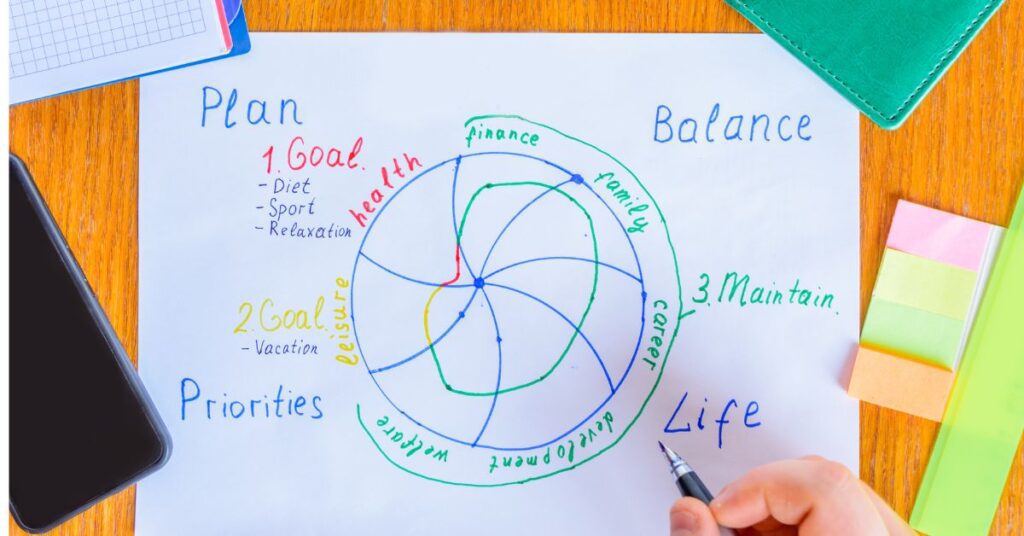From Assessment to Action with Your Life Wheel
Creating a personalized Life Wheel action plan transforms your assessment insights from interesting self-knowledge into a powerful roadmap for meaningful change. While completing your Life Wheel Assessment reveals where you stand across different life areas, developing a strategic action plan ensures you actually make progress toward greater balance and satisfaction rather than simply understanding your current situation.
The most common mistake people make after completing their Life Wheel Assessment is trying to improve everything at once, which leads to overwhelm, scattered efforts, and ultimately abandoning their improvement goals altogether. A well-designed Life Wheel action plan helps you prioritize strategically, focus your energy where it will have the greatest impact, and create sustainable momentum that builds over time.
Your personalized Life Wheel action plan serves as both a strategic framework and a practical tool for daily decision-making. It helps you allocate your time and energy intentionally, make choices that support your overall life balance, and track your progress in ways that maintain motivation and provide clear feedback about what’s working and what needs adjustment.
This step-by-step guide will show you exactly how to transform your Life Wheel Assessment results into a concrete, actionable plan that fits your unique circumstances, honors your values and priorities, and creates the kind of balanced progress that leads to lasting satisfaction across all areas of your life.
Table of Contents

Step 1: Analyze Your Life Wheel Assessment Results
Before creating your action plan, spend time thoroughly understanding what your Life Wheel Assessment reveals about your current life patterns, priorities, and opportunities for improvement.
Identify Your Priority Areas
The 3-Area Focus Rule Research from behavioral psychology shows that focusing on more than three major change areas simultaneously significantly reduces your likelihood of success in any area. Review your Life Wheel scores and identify the three areas that deserve your primary attention based on these criteria:
Urgent Areas (Scores 1-4): Areas scoring below 5 often create stress or dissatisfaction that affects other life areas. These typically deserve immediate attention, especially if they represent basic needs like health, financial security, or essential relationships.
High-Impact Areas: Some areas, when improved, create positive ripple effects throughout your life. Health improvements often boost career performance and relationship quality. Financial security reduces stress that affects multiple other areas. Strong relationships provide support that enhances your ability to pursue other goals.
Values-Aligned Areas: Areas that connect directly to your core values often provide the most motivation for sustained effort and create the greatest sense of fulfillment when improved. If creativity is a core value, focusing on recreation or personal growth might be more motivating than other areas.
Understand Your Patterns and Connections
Identify Keystone Areas Look for areas that significantly influence multiple other areas of your life. According to research by Charles Duhigg in “The Power of Habit,” keystone habits and areas create positive cascades that naturally improve other areas without direct effort.
Recognize Constraint Areas Some low-scoring areas may be constraining your progress in other areas. Financial stress might be preventing you from pursuing health improvements or personal growth opportunities. Poor health might be limiting your career performance or relationship energy.
Map Your Strengths High-scoring areas represent existing strengths and successful strategies that you can potentially apply to lower-scoring areas. If you’ve created success in your career through goal-setting and consistent action, these same approaches might work for health or relationship improvements.
Step 2: Set Strategic Improvement Goals
Transform your Life Wheel insights into specific, actionable goals that create meaningful progress without overwhelming your capacity for change.
The SMART-ER Goal Framework for Life Balance
Specific and Significant Instead of vague goals like “improve health,” create specific targets like “exercise 30 minutes, 4 times per week” or “prepare healthy meals 5 days per week.” Ensure your goals address significant aspects of the life area rather than superficial changes.
Measurable and Meaningful Establish clear metrics for tracking progress, but also ensure your goals connect to deeper meaning and values. “Lose 15 pounds” is measurable, but “increase energy and vitality to be more present with my family” connects to deeper motivation.
Achievable and Aligned Set goals that stretch you but remain realistic given your current circumstances, resources, and other commitments. Ensure your goals align with your core values and overall life vision rather than external expectations.
Relevant and Resourced Focus on goals that will genuinely improve your satisfaction in the target life area. Identify what resources, support, or skills you’ll need to achieve your goals and ensure they’re available or obtainable.
Time-bound and Trackable Set specific deadlines and create systems for regular progress tracking. This creates accountability and allows you to adjust your approach based on what you learn.
Exciting and Evaluated Choose goals that genuinely excite you and commit to regular evaluation and adjustment based on your progress and changing circumstances.
Goal Examples by Life Area
Health and Vitality Goals:
•”Complete a 20-minute walk during lunch break 5 days per week for the next 8 weeks”
•”Prepare and eat a nutritious breakfast at home 6 days per week for the next month”
•”Establish a consistent sleep routine, going to bed by 10:30 PM on weeknights for 30 days”
Relationship Goals:
•”Have one meaningful, uninterrupted conversation with my spouse each week for the next 3 months”
•”Reach out to one friend or family member each week to maintain connection”
•”Practice active listening by asking follow-up questions in conversations for the next 30 days”
Career Development Goals:
•”Complete one professional development course or workshop within the next 6 months”
•”Schedule monthly one-on-one meetings with my supervisor to discuss growth opportunities”
•”Update my resume and LinkedIn profile to reflect recent accomplishments within 2 weeks”

Step 3: Design Your Implementation Strategy
Create a practical framework for turning your goals into consistent daily and weekly actions that fit realistically into your current life structure.
The Habit Stacking Approach
Link New Actions to Existing Routines According to James Clear’s research in “Atomic Habits,” connecting new behaviors to established routines significantly increases the likelihood of consistency. Identify existing daily routines where you can add new life balance actions.
Examples of Effective Habit Stacks:
•”After I pour my morning coffee, I will write three things I’m grateful for” (Personal Growth)
•”After I finish lunch, I will take a 10-minute walk outside” (Health)
•”After I sit down at my desk each morning, I will review my daily priorities and ensure they align with my values” (Career/Personal Growth)
The Time Blocking Method
Weekly Life Balance Planning Dedicate specific time blocks in your weekly schedule to activities that support your priority life areas. This prevents important areas from being crowded out by urgent but less important demands.
Sample Weekly Time Blocks:
•Monday/Wednesday/Friday 7:00-7:30 AM: Exercise (Health)
•Tuesday/Thursday 6:00-6:30 PM: Personal learning time (Personal Growth)
•Saturday 10:00-11:00 AM: Quality time with family (Relationships)
•Sunday 7:00-7:30 PM: Weekly planning and reflection (Overall Balance)
The Minimum Viable Progress Principle
Start Smaller Than You Think Begin with actions so small they feel almost trivial. This builds consistency and confidence while establishing neural pathways that support larger changes over time. You can always increase intensity or duration once the habit is established.
Examples of Minimum Viable Actions:
•Health: 5 push-ups daily instead of a full workout routine
•Relationships: One genuine compliment daily instead of lengthy quality time
•Personal Growth: Read one page daily instead of completing entire books
•Recreation: 5 minutes of a hobby daily instead of lengthy creative sessions
Step 4: Create Your Weekly Life Balance Routine
Establish a sustainable weekly rhythm that ensures consistent attention to all your priority life areas while maintaining flexibility for life’s inevitable changes and challenges.
The Weekly Planning Session
Sunday Life Balance Review (20 minutes)
•Review the previous week’s progress across your priority areas
•Identify what worked well and what needs adjustment
•Plan specific actions for the upcoming week in each priority area
•Schedule time blocks for important activities before the week gets busy
Daily Check-ins (5 minutes)
•Morning: Review your daily priorities and ensure they include life balance actions
•Evening: Reflect on how well you honored your life balance commitments
•Adjust tomorrow’s plans based on today’s insights and energy levels

The Energy Management Approach
Match Activities to Energy Levels Different life areas require different types of energy. Schedule demanding activities during your peak energy times and lighter activities when your energy is lower.
High Energy Activities: Challenging workouts, difficult conversations, creative projects, learning new skills Medium Energy Activities: Routine exercise, meal preparation, organizing, planning Low Energy Activities: Reading, gentle stretching, gratitude practice, light social connection
Building Flexibility and Resilience
The 80% Rule Aim for 80% consistency rather than perfection. This allows for life’s inevitable interruptions while maintaining momentum toward your goals. Missing one day doesn’t derail your progress if you return to your routine the next day.
Emergency Protocols Develop simplified versions of your life balance activities for particularly busy or stressful periods:
•5-minute versions of your normal 30-minute activities
•Essential-only versions that maintain the most important elements
•Recovery plans for getting back on track after disruptions
Step 5: Track Progress and Maintain Motivation
Establish systems for monitoring your progress that provide both accountability and motivation while helping you learn what approaches work best for your unique situation.
Quantitative Tracking Methods
Weekly Scorecard System Create a simple tracking system that measures your consistency with key actions rather than just outcomes. This provides more immediate feedback and helps you identify patterns.
Sample Weekly Scorecard:
•Health Actions: Exercise sessions completed ___/4, Healthy meals prepared ___/5
•Relationship Actions: Quality conversations ___/2, Expressions of appreciation ___/7
•Personal Growth Actions: Learning time ___/3, Reflection sessions ___/2
Monthly Life Wheel Updates Re-rate your satisfaction in each life area monthly to track trends and overall progress. Look for gradual improvements rather than dramatic changes, as sustainable progress often happens slowly.
Qualitative Progress Assessment
Weekly Reflection Questions
•Which life area felt most balanced and satisfying this week?
•Where did I notice the most improvement or positive change?
•What challenges did I encounter, and how did I handle them?
•What insights did I gain about what works best for me?
•How did improvements in one area affect other areas of my life?
Energy and Satisfaction Tracking Notice changes in your overall energy levels, stress levels, and life satisfaction as you implement your action plan. These qualitative changes often appear before quantitative improvements and provide important motivation to continue.
Celebration and Adjustment Protocols
Weekly Wins Recognition Acknowledge and celebrate your progress, no matter how small. This reinforces positive behaviors and maintains motivation during challenging periods. Celebrations can be simple: a favorite meal, time in nature, or sharing your progress with a supportive friend.
Monthly Plan Adjustments Based on your tracking data and reflection insights, adjust your action plan monthly. This might involve:
•Modifying goals that prove too ambitious or too easy
•Changing strategies that aren’t working effectively
•Shifting focus between life areas based on changing circumstances
•Adding new actions that support your progress
Step 6: Build Your Support System
Create a network of support that helps you maintain consistency with your Life Wheel action plan while providing encouragement, accountability, and practical assistance when needed.
Accountability Partnerships
Life Balance Buddy System Partner with someone who is also working on life balance goals. Meet weekly or bi-weekly to share progress, challenges, and insights. This mutual accountability increases consistency and provides motivation during difficult periods.
Family and Friend Integration Share your Life Wheel goals with supportive family members and friends. Ask for specific support such as:
•Workout partners for health goals
•Study partners for learning goals
•Babysitting exchanges to create time for personal activities
•Encouragement and check-ins about your progress
Professional Support Resources
Coaching and Counseling Consider working with a life coach, therapist, or counselor if your Life Wheel reveals significant imbalances or if you’re struggling to create positive change on your own. Professional support can provide personalized strategies and help you work through obstacles that might be difficult to address independently.
Skill-Building Resources Identify classes, workshops, books, or online courses that can help you develop skills needed for your priority life areas. Investing in skill development often accelerates progress and increases confidence in your ability to create lasting change.
Community and Group Support
Interest-Based Communities Join groups or communities related to your improvement goals. This might include fitness groups, book clubs, professional associations, volunteer organizations, or hobby groups. These communities provide both social connection and practical support for your goals.
Online Support Networks Participate in online forums, social media groups, or apps that support your specific goals. Many people find motivation and practical tips from others who are working toward similar improvements.

Step 7: Integrate and Evolve Your Life Wheel Action Plan
Develop systems for continuously refining and evolving your approach based on what you learn about yourself, your changing circumstances, and your growing capacity for balanced living.
Quarterly Life Balance Reviews
Comprehensive Progress Assessment Every three months, conduct a thorough review of your Life Wheel action plan:
•Complete a new Life Wheel Assessment and compare to previous results
•Analyze which strategies have been most effective
•Identify areas where you need different approaches
•Celebrate significant progress and acknowledge challenges overcome
•Set priorities and goals for the upcoming quarter
Plan Evolution and Refinement Based on your quarterly review, evolve your action plan to reflect:
•New insights about what works best for your personality and lifestyle
•Changing life circumstances that require different approaches
•Increased capacity for challenge as you build confidence and skills
•Shifting priorities as some areas improve and others need attention
Long-Term Vision Integration
Annual Life Wheel Visioning Once yearly, step back from tactical planning to consider your broader life vision and how your Life Wheel action plan supports your long-term goals and values. This might involve:
•Updating your definition of satisfaction in different life areas
•Adjusting your priorities based on life stage changes
•Integrating new areas or modifying existing categories
•Aligning your life balance goals with your evolving sense of purpose
Legacy and Contribution Planning As your life becomes more balanced, consider how your growth and stability can contribute to others. This might involve mentoring others in areas where you’ve achieved satisfaction, volunteering for causes you care about, or sharing your knowledge and experience in ways that help others create better life balance.

Sustainable Life Balance Mastery
From Effort to Flow Over time, your Life Wheel action plan should evolve from requiring conscious effort to becoming a natural flow of balanced living. This mastery involves:
•Intuitive decision-making that naturally considers all life areas
•Automatic habits that support balance without conscious planning
•Resilience systems that help you maintain balance during challenging periods
•Integration of life areas so they support rather than compete with each other
For a deeper understanding of how to use your Life Wheel insights as part of a comprehensive personal development approach, explore our complete guide on self-assessment tools for personal growth. This broader framework helps you integrate your life balance work with other aspects of personal development for maximum effectiveness and satisfaction.
Your Life Wheel Action Plan as a Living Document
Your personalized Life Wheel action plan represents more than a goal-setting exercise—it’s a living document that evolves with you as you grow, learn, and navigate the changing circumstances of your life. The key to long-term success lies not in perfect execution of your initial plan, but in developing the skills and systems for continuously assessing, adjusting, and improving your approach to life balance.
Remember that creating sustainable life balance is a marathon, not a sprint. The habits, systems, and insights you develop through implementing your Life Wheel action plan become valuable life skills that serve you far beyond achieving your current goals. You’re not just improving specific life areas; you’re developing the capacity for conscious, intentional living that enhances every aspect of your experience.
The most successful people who use Life Wheel action plans understand that the process is as important as the outcomes. Each week of consistent action, each monthly review, and each quarterly adjustment builds your capacity for self-awareness, intentional choice-making, and resilient adaptation to life’s inevitable changes and challenges.
Your commitment to creating and following through on your Life Wheel action plan demonstrates wisdom and courage that will inspire others in your life. As you develop greater balance and satisfaction across all life areas, you naturally become a more present, capable, and positive influence in your relationships and community.
Embrace your Life Wheel action plan as an ongoing practice of conscious living rather than a temporary improvement project. Let it guide you toward a life that reflects your deepest values, utilizes your unique strengths, and creates the kind of balanced fulfillment that allows you to contribute your best to the world around you.
Life Wheel Action Plan Templates
Quick Start Action Plan Template
My Top 3 Priority Areas:
1._________________ (Current Score: ___/10, Target Score: ___/10)
2._________________ (Current Score: ___/10, Target Score: ___/10)
3._________________ (Current Score: ___/10, Target Score: ___/10)
This Week’s Specific Actions:
Priority Area 1:
•Monday: _________________________________
•Wednesday: _________________________________
•Friday: _________________________________
Priority Area 2:
•Tuesday: _________________________________
•Thursday: _________________________________
•Saturday: _________________________________
Priority Area 3:
•Daily: _________________________________
•Sunday: _________________________________
Monthly Planning Worksheet
Month: _____________ Year: _____________
Last Month’s Wins:
•
•
•
Areas Needing Adjustment:
•
•
This Month’s Focus Areas and Goals:
Area 1: _________________
•Specific Goal: _________________________________
•Weekly Actions: _________________________________
•Success Metric: _________________________________
Area 2: _________________
•Specific Goal: _________________________________
•Weekly Actions: _________________________________
•Success Metric: _________________________________
Area 3: _________________
•Specific Goal: _________________________________
•Weekly Actions: _________________________________
•Success Metric: _________________________________
Support Needed:
•Resources: _________________________________
•People: _________________________________
•Skills to Develop: _________________________________
Weekly Tracking Scorecard
Week of: _____________
Daily Actions Completed:
•Monday: Health ☐ Relationships ☐ Growth ☐
•Tuesday: Health ☐ Relationships ☐ Growth ☐
•Wednesday: Health ☐ Relationships ☐ Growth ☐
•Thursday: Health ☐ Relationships ☐ Growth ☐
•Friday: Health ☐ Relationships ☐ Growth ☐
•Saturday: Health ☐ Relationships ☐ Growth ☐
•Sunday: Health ☐ Relationships ☐ Growth ☐
Weekly Totals:
•Health Actions: ___/7
•Relationship Actions: ___/7
•Growth Actions: ___/7
Energy Level (1-10): Beginning of week ___ End of week ___ Life Satisfaction (1-10): ___ Biggest Win: _________________________________ Main Challenge: _________________________________ Next Week’s Focus: _________________________________
Quarterly Review Template
Quarter: _____ Year: _____
Life Wheel Score Changes:
•Career: Start ___ Current ___ Change ___
•Financial: Start ___ Current ___ Change ___
•Health: Start ___ Current ___ Change ___
•Relationships: Start ___ Current ___ Change ___
•Growth: Start ___ Current ___ Change ___
•Recreation: Start ___ Current ___ Change ___
•Environment: Start ___ Current ___ Change ___
•Contribution: Start ___ Current ___ Change ___
Most Improved Area: _________________________________ Strategies That Worked Best: _________________________________ Strategies to Modify: _________________________________ New Insights About Myself: _________________________________ Next Quarter’s Priorities: _________________________________
References:
Clear, James. “Atomic Habits: An Easy & Proven Way to Build Good Habits & Break Bad Ones.” Avery, 2018. https://jamesclear.com/
Duhigg, Charles. “The Power of Habit: Why We Do What We Do in Life and Business.” Random House, 2012.
Covey, Stephen R. “The 7 Habits of Highly Effective People.” Free Press, 1989. https://www.franklincovey.com/
Newport, Cal. “Deep Work: Rules for Focused Success in a Distracted World.” Grand Central Publishing, 2016.
Sinek, Simon. “Start with Why: How Great Leaders Inspire Everyone to Take Action.” Portfolio, 2009.
